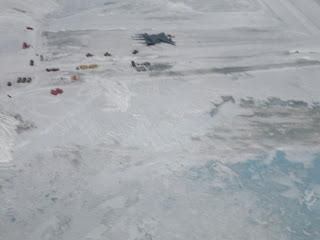Well it is time to leave the Ice. The night before our flight we all gather at the Air Transport Operations (ATO) building for "bag drag". We bring all of our luggage and wear - or at least have with us - the required extreme cold weather gear needed for the flight which includes windpants, 'big red', bunny boots and goggles/sunglasses.
We have ourselves and luggage weighed, show our passports and are cleared for the next morning's flight.
We report to the ATO at 2:15 am for our flight home on a C-17.
We all board Ivan the Terra-bus for the hour long ride to the Pegasus Airfield.
A view of Observation Hill from the road to Pegasus Airfield.
Once we get to Pegaus Airfield, we wait inside the Passenger Terminal.
Here are the heavy machines that are needed to offload and onload palleted cargo for the C-17.
The weather is right and the runway is good. The C-17 comes in for a perfect landing at 4 am.
Ivan the Terra-bus is in position for the departing C-17 passengers. Others wait to board the C-17.
Passengers depart the C-17 and equipment moves in to offload the cargo.
Close up of the C-17 cargo operation. The engines never shut off during offload and onload of passengers and cargo. Great care is exercised during these operations for the safety of all involved.
We can finally head toward our flight out!
It really is an amazing aircraft!
Inside the cargo area. Some decide to lie on the floor and sleep during the 5 hour ride to Christchurch, New Zealand - our long awaited destination.
We make it to Christchurch by 10:30am local time.
A wet day, but a well received welcome. We all notice the trees and humidity and warmth!
My time on the ice is at an end for this time around.
Only time will tell to see if I return again to the great adventure that is Antarctica.
































